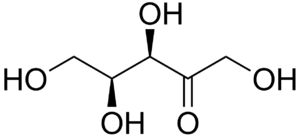Xylulose
Xylulose is a ketopentose, a monosaccharide containing five carbon atoms, and including a ketone functional group. It has the chemical formula C5H10O5. In nature, it occurs in both the L- and D-enantiomers.[3] 1-Deoxyxylulose is a precursor to terpenes via the nonmevalonic acid pathway.[4]
 | |||
| |||
| Names | |||
|---|---|---|---|
| IUPAC name
(3R,4S)-1,3,4,5-Tetrahydroxypentan-2-one | |||
| Other names
threo-Pentulose threo-2-Pentulose | |||
| Identifiers | |||
3D model (JSmol) |
|||
| ChEBI | |||
| ChemSpider | |||
PubChem CID |
|||
| UNII |
| ||
| |||
| |||
| Properties | |||
| C5H10O5 | |||
| Molar mass | 150.13 g/mol | ||
| Appearance | colorless syrup | ||
Except where otherwise noted, data are given for materials in their standard state (at 25 °C [77 °F], 100 kPa). | |||
| Infobox references | |||
Pathology
L-Xylulose accumulates in the urine in patients with pentosuria, due to a deficiency in L-xylulose reductase. Since L-xylulose is a reducing sugar like D-glucose, pentosuria patients have been wrongly diagnosed in the past to be diabetic.
gollark: Those are not, as far as I know, actually that competitive.
gollark: There's just a lot of waste on stuff like advertising and reinventing things done by competitors which is at least theoretically avoidable.
gollark: No, we have perfectly functional competitive markets for things like food and TVs and furniture and whatever.
gollark: Central planning instead of our competitive systems could be way more efficient, except the incentives don't really work and nobody can be trusted to do it.
gollark: It's possible that I don't really like informal social/status-game-y methods of distributing things because I'm not very good at them and find them unpleasant. But I still don't really like them.
References
- Data is for L-xylulose.
- Merck Index, 11th Edition, 9996.
- Winkelhausen, Eleonora; Kuzmanova, Slobodanka (1998). "Microbial conversion of d-xylose to xylitol". Journal of Fermentation and Bioengineering. 86: 1–14. doi:10.1016/S0922-338X(98)80026-3.
- Rohdich, F.; Bacher, A.; Eisenreich, W. (2005). "Isoprenoid biosynthetic pathways as anti-infective drug targets". Biochemical Society Transactions. 33 (4): 785–791. doi:10.1042/BST0330785. PMID 16042599.
This article is issued from Wikipedia. The text is licensed under Creative Commons - Attribution - Sharealike. Additional terms may apply for the media files.

